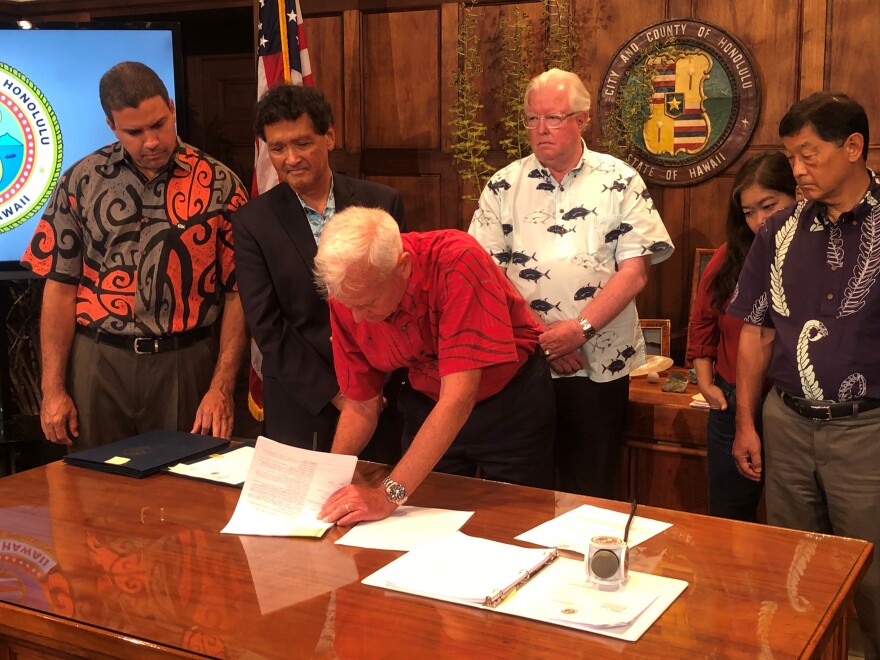The number of vacation rentals on Oahu declined more than 5 percent from the same time last year. Honolulu’s recent restrictions on short-term renting appear to be the cause.
According to data from the Hawaii Tourism Authority, the number of rental nights available on Oahu declined from more than 270,000 in October 2018 to just over 257,000 in October 2019, a 5 percent reduction.
That is in sharp contrast to Maui, Kauai, and Hawaii Island, which all posted double digit increases in the number of vacation rental nights available over the same period.
Even more telling is when the downward trend on Oahu began. Travel industry consultant Erik Kloninger, whose firm worked on the HTA data, says Oahu was on the same growth path as the rest of the state until August, when the City and County of Honolulu’s new law to crackdown on illegal short-term rentals took effect.
The Honolulu City Council passed Bill 89 in June, after more than a year of emotional and often confrontational public input. Although the vast majority of short-term rentals, defined as fewer than 30 days, were already illegal under a 1989 law, enforcement proved practically difficult for regulators.
Only around 800 properties have a permit to operate a short-term rental under the 1989 law. But lax enforcement led to a much greater number operating, as many as 10,000 by one estimated.
The island’s chronic shortage of affordable housing led to calls for reining in the practice, which had fueled the growth of an entire industry of support businesses like cleaners, property managers and landscapers.
Bill 89, now known as Ordinance 19-18, sought to punish violators with fines up to $10,000 per day. Importantly, the law also allows authorities to issue violations solely based upon a property's listing on a short-term rental site like Airbnb, VRBO or HomeAway, eliminating the need for lengthy stakeouts that previously made enforcement impractical.

The Honolulu Department of Permitting and Planning has issued thousands of warning letters to suspected violators and a few dozen notices of violation.
Bill 89 does allow short-term rentals to operate in the resort districts of Waikiki, Ko Olina, and Turtle Bay. Erik Kloninger says the law appears to be achieving its intended purpose of shifting visitors towards resort areas and away from residential neighborhoods.
“The Waikiki supply is up 23 percent year over year. The supply in the suburban submarkets like the Windward side, North Shore, and other Honolulu all reported decrease of high 20s to low 30%,” Kloninger told HPR.
He also noted that despite the decrease in supply, demand continued to rise on Oahu, albeit by a modest 0.8% island-wide. Statewide, consumer demand for vacation rentals rose by 21 percent, with all other islands posting double digit increases between 20 and 40 percent.
Kloninger say the strength of demand will provide a strong incentive for property owners to continue offering units for short-term rent. That comes as Maui and Hawaii County are moving to implement vacation rental restrictions of their own.

What remains unclear is what happened to the properties that dropped out of the short-term rental market. Jenny Brady, president of the Honolulu Board of Realtors, told HPR there was no statistically significant change in the housing market around the time Honolulu’s crackdown took effect.
“It doesn't appear that there has been a significant increase in inventory to the market as it relates to Bill 89,” Brady said.
The lack of market change indicates there was not a rush to sell rental properties when enforcement of 19-18 occurred.
One possibility is that those units were transitioned to long-term rentals for Oahu residents. The Honolulu Board of Realtors does not currently track data on long-term rentals and could not provide any insight on any changes in the supply of them.
Current law allows property owners to provide rentals without a permit, as long as the length of stay is at least 30 days. Kloninger says a growing number of listings are asking for a minimum stay of 30 days, meaning the supply side of the market may be shifting in that direction.
Another possibility is that owners are taking a wait-and-see approach, pulling vacation rentals from online booking platforms to monitor what action city authorities are taking.
A quick scan of sites like Airbnb and VRBO indicates that many owners are willing to risk being fined. Dozens of rentals are still available outside of resort zones on any given day.
With an ever-increasing number of visitors arriving in Hawaii, and competitive pricing when compared to hotels, demand for vacation rentals will likely continue to grow. Many owners still appear ready to oblige them.




